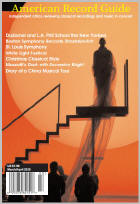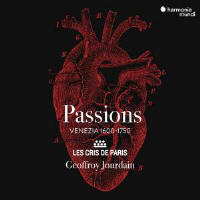Texte paru dans: / Appeared in: Harmonia Mundi |
|
|
Outil de traduction ~ (Très approximatif) |
|
|
Reviewer: William
J. Gatens
This recording contains music
spanning nearly 150 years between 1600 and 1750 by composers who were either
native Venetians or had strong professional associations with the city. The
music is both vocal and instrumental. The vocal music includes pieces with
liturgical texts as well as ones for private devotion in a domestic setting
with Latin and Italian texts. The booklet contains a transcript of an
interview with Geoffroy Jourdain, the founder and director of Les Cris de
Paris. He deliberately chose a title, “Passions”, that is open to
interpretation: the Passion of Christ, the baroque expression of the
emotional affections, and his own personal passion for Venetian music of
this period. He points out that the boundary between sacred and secular was
not as sharply drawn at that time as it is now, and in music there was
strong reciprocal influence. In some respects St Mark’s Basilica was like a
theater for polychoral liturgical music. Venice was probably the main center
for 17th Century opera, and it is only to be expected that dramatic
expression in the opera theater would be reflected in religious devotion.
The music presented here is very different from the contemplative serenity
of 16th-Century Roman sacred polyphony epitomized by Palestrina.
The program begins with a
piece that brings many of these facets together: the spiritual canzonetta
‘Hor ch’e Tempo di Dormire’ by Tarquinio Merula (c1594-1665). It is a sad
lullaby for a solo soprano who is the Virgin Mary singing to the baby Jesus.
The text explicitly invokes the violence of the Passion to come, some 30
years later. To add to the emotional tension between that violence and an
outwardly gentle lullaby, nearly the whole of the song—and it is a
substantial one, taking nine minutes in performance—is built on a two-note
ostinato of a rising semitone. There appears to be some editorial orchestration going on as bowed and plucked string instruments are gradually added to produce a massive crescendo of increasing volume and textural complexity that afterward subsides. Anachronistic? Probably, but indisputably effective and, as Jourdain might put it, passionate. The program is punctuated by five settings of the text ‘Crucifixus etiam pro nobis. One is in four parts by Claudio Monteverdi (1567-1643) from his Selva Morale e Spirituale (1640-41). Three are by Antonio Lotti (1666- 1740) in 6, 8, and 10 parts. The latest music here is a 16-part setting by Antonio Caldara (1671-1736). It is juxtaposed with the earliest piece on the program, the motet ‘Exaudi me, Domine’ for 4 choirs of 4 voices each (so it is also for 16 voices) by Giovanni Gabrieli (c1555-1612). Inserted among the vocal pieces are suitably somber instrumental movements, including interludes from stage and vocal works by Monteverdi, part of a sonata by Giovanni Legrenzi (1626-90), and a strange and austere ‘Balletto Secondo Pretirata’ by Biagio Marini (1594-1663), played first by bowed strings and then on the theorbo. I reviewed a recording of a similar themed program by Jourdain and Les Cris de Paris: “Melancholia—Madrigals and Motets around 1600” (HM 902298; J/F 2019, p 189). That offered a fascinating comparison of pieces by English and Italian composers from
a narrower chronological range
than this recording. In both cases, the performances are outstanding. | |
|
|
|
|
Cliquez l'un ou l'autre
bouton pour découvrir bien d'autres critiques de CD |
|




